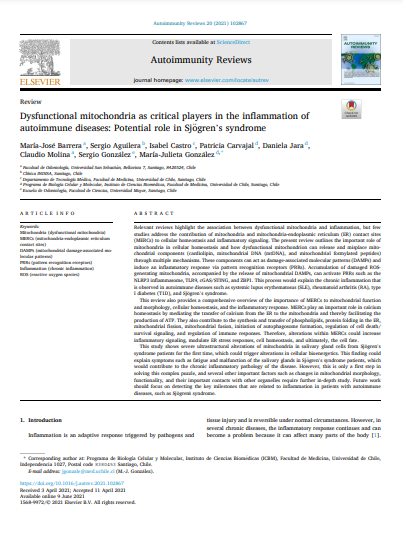Dysfunctional mitochondria as critical players in the inflammation of autoimmune diseases: Potential role in Sjo¨gren's syndrome

Fecha
2021-07-23Autor
Barrera, Maria-Jose
Aguilera, Sergio
Castro, Isabel
Carvajal, Patricia
Jara, Daniela
Molina, Claudio
Gonzalez, Maria-Julieta
Gonzalez, Sergio [Univ Mayor, Fac Ciencias, Escuela Odontol, Santiago, Chile]
Ubicación geográfica
Notas
HERRAMIENTAS
Acceda a títulos restringidos
¿Cómo descargar?Resumen
Relevant reviews highlight the association between dysfunctional mitochondria and inflammation, but few studies address the contribution of mitochondria and mitochondria-endoplasmic reticulum (ER) contact sites (MERCs) to cellular homeostasis and inflammatory signaling. The present review outlines the important role of mitochondria in cellular homeostasis and how dysfunctional mitochondrion can release and misplace mitochondrial components (cardiolipin, mitochondrial DNA (mtDNA), and mitochondrial formylated peptides) through multiple mechanisms. These components can act as damage-associated molecular patterns (DAMPs) and induce an inflammatory response via pattern recognition receptors (PRRs). Accumulation of damaged ROSgenerating mitochondria, accompanied by the release of mitochondrial DAMPs, can activate PRRs such as the NLRP3 inflammasome, TLR9, cGAS/STING, and ZBP1. This process would explain the chronic inflammation that is observed in autoimmune diseases such as systemic lupus erythematosus (SLE), rheumatoid arthritis (RA), type I diabetes (T1D), and Sjo & uml;gren's syndrome. This review also provides a comprehensive overview of the importance of MERCs to mitochondrial function and morphology, cellular homeostasis, and the inflammatory response. MERCs play an important role in calcium homeostasis by mediating the transfer of calcium from the ER to the mitochondria and thereby facilitating the production of ATP. They also contribute to the synthesis and transfer of phospholipids, protein folding in the ER, mitochondrial fission, mitochondrial fusion, initiation of autophagosome formation, regulation of cell death/ survival signaling, and regulation of immune responses. Therefore, alterations within MERCs could increase inflammatory signaling, modulate ER stress responses, cell homeostasis, and ultimately, the cell fate. This study shows severe ultrastructural alterations of mitochondria in salivary gland cells from Sjo & uml;gren's syndrome patients for the first time, which could trigger alterations in cellular bioenergetics. This finding could explain symptoms such as fatigue and malfunction of the salivary glands in Sjo & uml;gren's syndrome patients, which would contribute to the chronic inflammatory pathology of the disease. However, this is only a first step in solving this complex puzzle, and several other important factors such as changes in mitochondrial morphology, functionality, and their important contacts with other organelles require further in-depth study. Future work should focus on detecting the key milestones that are related to inflammation in patients with autoimmune diseases, such as Sjo & uml;gren & acute;s syndrome.
URI
https://repositorio.umayor.cl/xmlui/handle/sibum/9071https://doi.org/10.1016/j.autrev.2021.102867
https://doi-org.bibliotecadigital.umayor.cl:2443/10.1016/j.autrev.2021.102867
https://pubmed.ncbi.nlm.nih.gov/34118452/
Coleccion/es a la/s que pertenece:
Si usted es autor(a) de este documento y NO desea que su publicación tenga acceso público en este repositorio, por favor complete el formulario aquí.